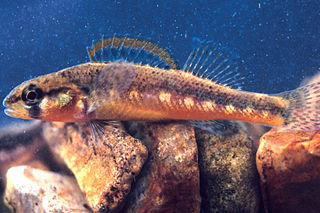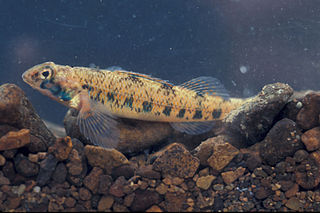
The snail darter is a small species of freshwater ray-finned fish, a darter from the subfamily Etheostomatinae, part of the family Percidae, which also contains the perches, ruffes and pikeperches. It is found in East Tennessee freshwater in the United States and in small portions of northern Alabama and Georgia. First recorded in 1973, the snail darter was listed as endangered under the U.S. Endangered Species Act of 1973 by 1975. The species was at the center of a major environmental law controversy that involved a lawsuit seeking to halt the completion of Tellico Dam, which posed a risk of extinction for the snail darter by blocking its migratory route. The case was eventually appealed to the U.S. Supreme Court, which ruled on it in its 1978 decision Tennessee Valley Authority v. Hill.

The slackwater darter is a small species of the freshwater ray-finned fish and a darter from the subfamily Etheostomatinae, part of the family Percidae, which also contains the perches, ruffes and pikeperches. Some authors consider it to be a member of the stippled darter group. The slackwater darter has a conspicuous dark subocular bar and three prominent saddles. It is rather drab in color, with the dorsum being dusky, olivaceous, or brownish. The lateral blotches are dark brown to blue-black. The venter is slightly dusky and may have some orange and yellow pigments, which are more intense in males than in females. Maximum size is about 55 millimetres (2.2 in) standard length.
The Maryland darter is a species of freshwater ray-finned fish, a darter from the subfamily Etheostomatinae, part of the family Percidae, which also contains the perches, ruffes and pikeperches. It is considered one of the rarest freshwater fish species in the world, due in part to its incredibly limited geographic range and difficulty of detection. The last sighting of one was in 1988. The Maryland darter is named after the only state in which it is known to occur. The species was long known only by two specimens until being "re-discovered" in 1962. From 1965 into the 1980s, the species was believed to have been confined to a single riffle in Deer Creek. Possible explanations for the decline of the species center around widespread habitat degradation and reduction in water quality resulting from increasing rates of urbanization within the watershed. While the IUCN has declared the species extinct, the United States Fish and Wildlife Service has not, and keeps it on the Endangered Species List.
The Florida bog frog is a rare species of frog found only in western Florida.

The watercress darter is a species of freshwater ray-finned fish, a darter from the subfamily Etheostomatinae, part of the family Percidae, which also contains the perches, ruffes and pikeperches. It is endemic to the eastern United States where it is only known from the Black Warrior River drainage basin near Birmingham, Alabama.

Etheostoma osburni, the candy darter or finescale saddled darter, is a species of fish in the family Percidae, a member of the group known as darters. This species is endemic to the eastern United States where it is known only from the Kanawha River system in the states of Virginia and West Virginia.
The Bayou darter is a rare species of freshwater ray-finned fish, a darter from the subfamily Etheostomatinae, part of the family Percidae, which also contains the perches, ruffes and pikeperches. It is endemic to western Mississippi in the United States, where it is found only in Bayou Pierre and its tributaries. Its typical habitat is fast-flowing creeks and streams, in riffles and in areas between riffles with firm gravel bottoms. It feeds on small insects and their larvae. Breeding probably takes place twice a year, in spring and late summer. The population of this fish is declining due to loss of suitable habitat. This is caused by siltation and pollution, particularly erosion caused by changes in land use. The International Union for Conservation of Nature has assessed its conservation status as being "endangered".

The boulder darter is a species of freshwater ray-finned fish, a darter from the subfamily Etheostomatinae, part of the family Percidae, which also contains the perches, ruffes and pikeperches. It is endemic to Alabama and Tennessee in the United States, where it occurs in the Elk River system and Shoal Creek. It is found in small rivers and fast-flowing streams, at least 2 ft (0.6 m) deep, with boulders or a rocky base. It feeds on aquatic insect larvae but little is known of its natural history. The population trend of this fish is unknown but it is affected by a rise in siltation and the impoundment of water within its range by the building of dams. The International Union for Conservation of Nature has assessed its conservation status as being "vulnerable".

Medionidus penicillatus, the gulf moccasinshell, is a rare species of freshwater mussel in the family Unionidae, the river mussels. This aquatic bivalve mollusk is native to Alabama, Florida, and Georgia in the United States, where it is in decline and has been extirpated from most of the rivers it once inhabited. It is a federally listed endangered species of the United States.

The vermilion darter is a species of freshwater ray-finned fish, a darter from the subfamily Etheostomatinae, part of the family Percidae, which also contains the perches, ruffes and pikeperches. It is endemic to the southern United States, where it only is found in Turkey Creek in Jefferson County, Alabama, part of the Mobile Bay drainage basin. It was first described by Herbert Boschung in 1992, who was the curator of ichthyology at the University of Alabama, along with biologist Richard Mayden and scientific illustrator Joseph Tomelleri. On December 7, 2010, the US Fish and Wildlife Service designated 13 mi (21 km) of Turkey Creek watershed as critical habitat for the darter. According to the IUCN, the population of this fish is declining.

The bluemask darter is a species of freshwater ray-finned fish, a darter from the subfamily Etheostomatinae, part of the family Percidae, which also contains the perches, ruffes and pikeperches. It is endemic to the eastern United States. It is a federally listed endangered species of the United States. This fish was not formally described until 2009, but it was added to the US Endangered Species List in 1993. During breeding, the male has bright blue patches on its head and other areas. This fish is found only in the Caney Fork River system, a tributary of the Cumberland River in Tennessee. The species name akatulo comes from the Cherokee for "mask", referring to the solid blue coloration on the lower face of the fish.

The buffalo darter is a species of freshwater ray-finned fish, a darter from the subfamily Etheostomatinae, part of the family Percidae, which also contains the perches, ruffes and pikeperches. It is found in the tributaries of the lower Duck and lower Tennessee Rivers. It is distinguished from other darter species by the presence of eight anal rays, as well breeding males having a unique hump behind the head reminiscent of a buffalo.

The blueside darter is usually found in the Tennessee River drainage in Tennessee, Alabama, North Carolina, and Virginia, and less commonly found in Bear Creek, Shoal Creek, and Barren Fork.
The lollipop darter is a species of freshwater ray-finned fish, a darter from the subfamily Etheostomatinae, part of the family Percidae, which also contains the perches, ruffes and pikeperches. It is endemic to the eastern United States. Lollipop darters are approximately 1.4 to 2.4 inches long.
The Citico darter is a threatened species of freshwater ray-finned fish, a darter from the subfamily Etheostomatinae, part of the family Percidae, which also contains the perches, ruffes and pikeperches. It is native to Tennessee. This species was formerly subsumed within Etheostoma percnurum. The E. percnurum group now consists of four distinct species: E. percnurum, E. marmorpinnum, E. lemniscatum, and E. sitikuense.

The Cherokee darter is a rare species of freshwater ray-finned fish, a darter from the subfamily Etheostomatinae, part of the family Percidae, which also contains the perches, ruffes and pikeperches. It is endemic to Georgia in the United States, where it is limited to the Etowah River system. It inhabits creeks with rocky bottoms and little silt, typically occurring just above and below riffles. It is a whitish or yellowish fish with green and black spots on the flanks and eight dark saddle-like bars dorsally. It has a small range and its habitat is being degraded and fragmented, and the International Union for Conservation of Nature has assessed its conservation status as being endangered.
The Cumberland darter is a rare species of freshwater ray-finned fish, a darter from the subfamily Etheostomatinae, part of the family Percidae, which also contains the perches, ruffes and pikeperches. It is endemic to Kentucky and Tennessee in the United States, where it occurs in the upper Cumberland River tributaries above Cumberland Falls. It was federally listed as an endangered species in the US on August 9, 2011.

Etheostoma etowahae, the Etowah darter, is a species of freshwater ray-finned fish, a darter from the subfamily Etheostomatinae, part of the family Percidae, which also contains the perches, ruffes and pikeperches. It is a rare species which is endemic to Georgia in the United States, where it occurs only in the Etowah River and two of its tributaries. It is a federally listed endangered species of the United States.

The relict darter is a rare species of freshwater ray-finned fish, a darter from the subfamily Etheostomatinae, part of the family Percidae, which also contains the perches, ruffes and pikeperches. It is endemic to Kentucky, where it occurs only in the drainage of the Bayou de Chien. It is a federally listed endangered species of the United States.

The rush darter is a rare and endangered species of freshwater ray-finned fish, a darter from the subfamily Etheostomatinae, part of the family Percidae, which also contains the perches, ruffes and pikeperches. It is endemic to Alabama in the United States, where it occurs in three river systems. It was federally listed as an endangered species of the United States on August 9, 2011.
Collette, B.B., and R.W. Yerger. 1962. The American Percid Fishes of the Subgenus Villora. Tulane Stud. Zool. 9:213-230.
Mettee, M.F., and E. Crittenden. 1979. A study of Etheostoma okaloosae (Fowler) and E. edwini (Hubbs and Cannon) in Northwestern Florida, 1975-78. Rep. to U.S. Fish and Wild. Serv., Atlanta, GA.
Ogilvie, V.E. 1980. Endangered Wildlife Project. E-1, Study I-J: Okaloosa darter investigation. Completion report, October 1, 1977-June 3O, 1980. Fla. Fresh Water Fish Comm., Tallahassee.
U.S. Fish and Wildlife Service. 1981. Recovery Plan for the Okaloosa Darter (Etheostoma okaloosae). Prepared by the Okaloosa Darter Recovery Team for U.S. Fish and Wildlife Service, Atlanta Georgia. 24 pp.
Yerger, R.W. 1978. Okaloosa Darter, pp. 2–4. In C.R. Gilbert (ed.). Rare and endangered biota of Florida. Vol. 4, Fishes. Univ. Press. Fla., Gainesville.















